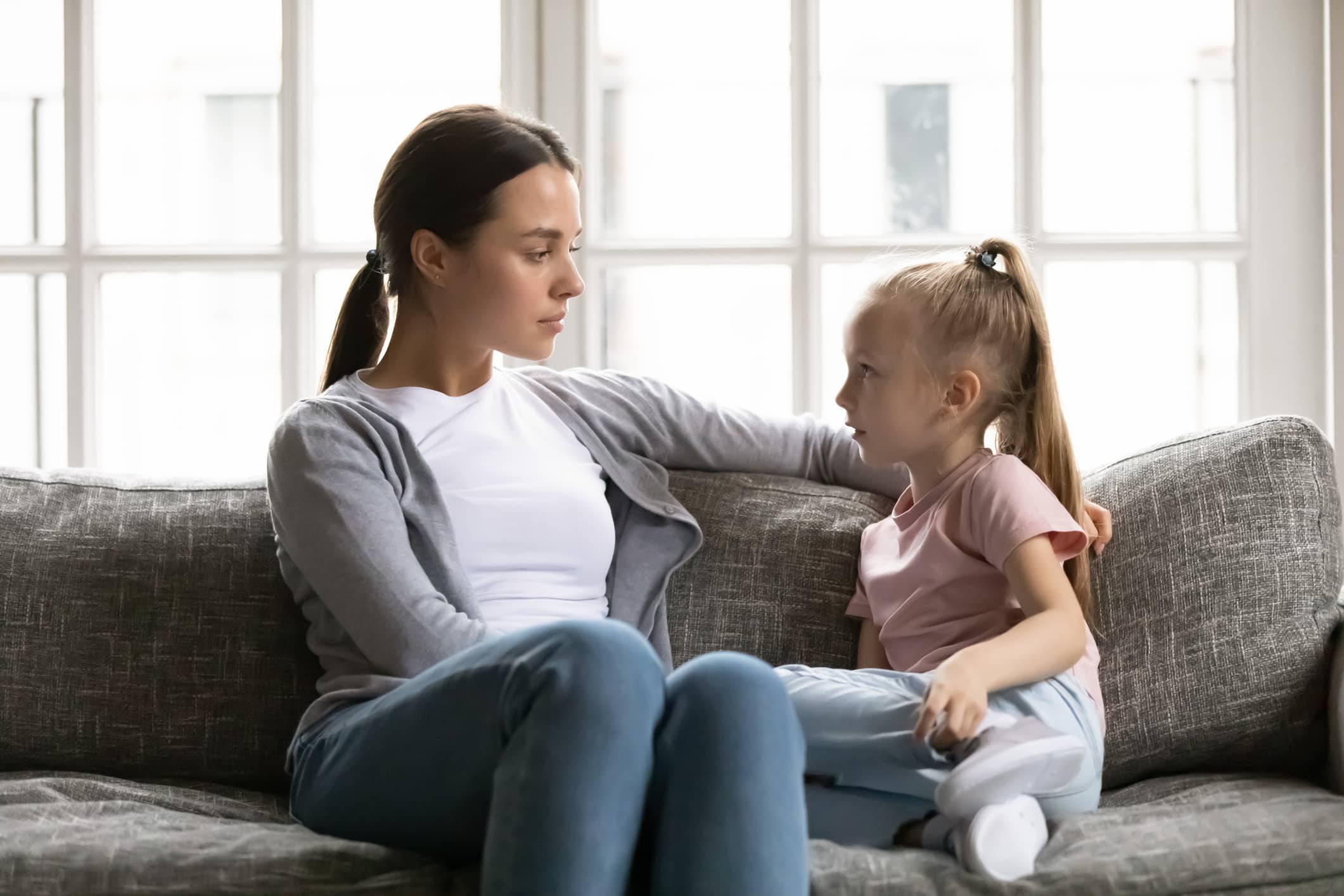By Dr. Jon Caldwell, D.O., Ph.D.
Several months ago, as I sat waiting to board a flight, my attention was captivated by an active toddler sitting (for the most part) on her mother’s lap. Beneath naturally curly locks of hair, her eyes, bright and curious, darted about the busy terminal, feasting on the smorgasbord of novel stimuli.
When a scruffy-looking man passed by in a wheelchair and offered a gnarled hand to the young child, she fearfully buried her face in her mother’s loose-fitting sweater. The girl’s mother instinctively pulled her close and whispered softly in her ear while giving the grizzled man an apologetic smile.
As the man pushed on, his course laughs lingering in the air, the girl gingerly emerged from her safe, sweater cocoon to survey the scene. Still, within her mother’s secure embrace, the girl stood up and ventured an inquisitive glance in the direction of the retreating man. Her fear had been down-regulated, and she could explore the environment again.
Attachment theory suggests that the earliest attachment bonds significantly impact children throughout their lives.
What Is Attachment Theory?
John Bowlby, a British psychologist, described attachment as a lasting psychological connectedness between human beings. Bowlby studied the relationship between children and their primary caregivers, focusing on the anxiety and distress they feel when they’re separated from them. Early behavioral theories suggest that attachment theory in early childhood is a learned behavior, fostering a “feeding relationship” between children and their caregivers. As a result, attachment bonds form because caregivers feed and nourish their children.
Bowlby’s attachment theory also found that the “feeding relationship” didn’t diminish separation anxiety. Instead, it’s characterized by behavioral and motivational patterns. Children have an innate drive to form emotional attachments with their caregivers. When children are frightened, they seek comfort from their caregivers. As a result, attachment theory suggests that the earliest attachment bonds significantly impact children throughout their lives.
How Attachment Theory Influences Social-Emotional Development
Interactions like the one above between a parent and child are repeated regularly throughout early development. From the attachment theory perspective, these dyadic experiences are the foundation for all social-emotional development. It’s noteworthy that attachment behavior and experiences between two minds and two bodies from the earliest moments of life.
Illustrated by the example above, the mother sensitively responded to the nonverbal intentions and emotions of the child by communicating safety and security through an embodied interaction. In this way, attachment behavior, whether secure or insecure (as in the case of relational trauma and abuse), is incorporated into the body’s self-regulatory systems and, as a result, can play an important role in how the body reacts and responds in close relationships later in life.
Attachment Theory and Relational Trauma
This article is part of a series on attachment theory and relational trauma. It’s meant to illustrate how Bowlby’s attachment theory can guide a therapeutic approach that incorporates working with emotions and the body. To ensure patient confidentiality and anonymity, the clinical example in this article is a fictional account based on many different patient histories and various treatment experiences. Although the following clinical information isn’t associated with one person, it represents many people who have experienced relational trauma.
Karen was a 37-year-old divorced female who entered treatment after becoming depressed and suicidal following a breakup with a boyfriend. She reported that symptoms of depression and anxiety had been a problem for most of her life, but they always got much worse during relationship turmoil. Similar to previous episodes, when the most recent relationship ended, she turned to alcohol and binge eating to numb the pain.
Karen reported feeling a profound sense of emptiness and loss whenever a romantic relationship ended. After her partner left, she couldn’t stop thinking about what she might have done wrong and feared that she would never have a healthy relationship. She fantasized incessantly about getting back together and about how she would “fix” herself to make the relationship work. These thoughts plagued her day and night until the helplessness and despair were overwhelming.
Uncovering Your Attachment Style
As a child, Karen’s mother struggled with alcoholism, and her father with workaholism; she remembered feeling like she was constantly hungry for their attention and love. In fact, as a young girl, she was certain that her father had a trap door in his office where he would disappear and carry out his “secret life.” Even when her parents were available, she often worried that she was “annoying” and feared her desire for attention would drive them away.
Karen’s parents divorced when she was nine years old, and their separation only intensified her father’s distance and her mother’s alcoholism. The pain and loneliness associated with her parents’” divorce were partially ameliorated by a warm and loving relationship with her maternal aunt. The latter had been a stable figure throughout her life. However, at thirteen years old, her aunt died, and not long after that, Karen began using food and alcohol in excess to overcome her attachment issues and alter her mood.
Karen’s childhood history indicated that she likely had insecure attachment behavior with both parents that could be categorized as ambivalent/preoccupied. In other words, her early development was marked by implicit feelings of insecurity because she was unsure whether or not her parents could consistently provide a safe and secure presence in her times of need.
Additionally, she believed this lack of security was her fault, which led to a pervasive fear of abandonment and a preoccupation with maintaining closeness. These patterns of thinking and feeling seemed to carry over into adulthood where her romantic relationships were characterized by an anxious attachment style and showed clear signs of love addiction.
Formulating a Personalized Treatment Plan
This kind of assessment of Karen’s attachment style was beneficial in formulating her treatment plan at The Meadows. Recognizing that she would likely harbor tremendous fear and anxiety about rejection and abandonment, treatment providers were careful to establish a secure therapeutic environment with clear limits and boundaries with a consistent, warm, and responsive presence (elements missing from her early attachment relationships).
Through various forms of treatment (including highly experiential inner-child work), she acknowledged and processed long-held feelings of pain, fear, anger, and shame regarding her early attachment style.
Although Karen strongly identified with the concept of love addiction, halfway through her treatment, she was still struggling with intense thoughts and emotions regarding her attachment issues and unhealthy relationship that preceded treatment.
During a session when she was particularly emotional about this subject, the therapist asked Karen to close her eyes and imagine what it would feel like to finally end the relationship and say goodbye to the relationship partner. Karen said, “It would feel like saying goodbye to a part of me… there would be a hole in there.” She pointed to her chest. The therapist asked, “As you imagine that hole in your chest, what does it feel like in your body?” Karen’s face winced, and her eyes shut tight as she responded, “It’s like a sharp, stabbing sensation.”
The therapist inquired, “As you are feeling the stabbing sensation in your chest, do you notice any other thoughts or emotions?” Karen paused, her hand over her chest, “I worry that the hole will never be filled — that I will never find anyone else.” The therapist tenderly implored, “How does it feel in your body as you say that?” Her breathing increased, and her shoulders tensed upwards, “Now I feel tightness in my chest and throat.” Knowing that the tightness was likely defending against something even more vulnerable, the therapist deepened the approach, “What would happen if you never found anyone else? What would that say about you?” Karen’s shoulders released, she bent over slightly and began to cry, “Maybe it’s me… maybe I’m just unlovable.” The therapist gently asked, “How does that feel in your body?” Through streaming tears, Karen replied, “There’s a deep ache in the pit of my stomach – that’s where the hole leads – that’s where it ends. It really hurts.”
Karen was invited to stay in touch with the deep ache in her stomach while the therapist guided her in some breathing exercises. Once Karen’s emotions were more regulated, the therapist asked her to think about a relationship in childhood where she felt unconditional acceptance and love.
Karen immediately identified her deceased aunt, and tears welled up in her eyes again. The therapist queried, “If your aunt were here right now, how would she respond to the deep ache you are feeling?” Karen was still crying, but a faint smile came across her face, “She would give me a big hug, and then she would just stay here with me.” The therapist asked, “When you think about your aunt’s response, how does that feel in your body?” Her frame straightened, and her smile broadened, “It feels warm all over… more open and free inside my body.” After a few moments of quiet introspection, she spontaneously added, “The ache is gone.”
Relying on the wisdom of her body (and with help from the therapist), Karen was able to drop below the habitual thoughts and feelings associated with love addiction and experience the pain associated with early attachment issues and insecurity (i.e., “I’m unlovable”). More importantly, she can contrast, and even dissolve, this deep pain through an embodied experience of secure attachment (i.e., “unconditional acceptance and love”).
Later she had great difficulty describing this therapeutic process in words, but it proved to be an “emotionally corrective experience” that she carried with her throughout her treatment. Gradually, by bringing awareness to her body’s feelings and associated thought processes, Karen learned more about her love addiction patterns and advanced tools to tap into a hidden wellspring of compassion and positive regard for herself.
The mental and emotional scripts associated with attachment theory in early childhood are written into the neurobiology of the developing child and are often acted out during the stage of romantic relationships without conscious awareness.
Childhood Experiences Shape Our Adult Relationships
Like most people, Karen’s childhood experiences with attachment figures profoundly influenced how she felt about herself and her relationship partners. Indeed, the mental and emotional scripts associated with attachment theory in early childhood are written into the neurobiology of the developing child and are often acted out during the stage of romantic relationships without conscious awareness. Fortunately, meaningful and lasting alterations to these scripts can be facilitated by various therapeutic techniques, particularly those that are experiential and involve working with the body and your emotions.



